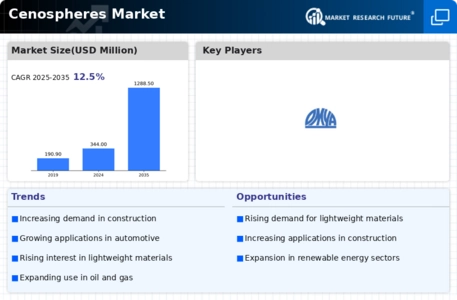Market Growth Projections
The Global Cenospheres Market Industry is projected to experience robust growth over the coming years. With a market value anticipated to reach 344 USD Million in 2024 and an impressive increase to 1288.5 USD Million by 2035, the trajectory indicates a strong upward trend. The compound annual growth rate of 12.76% from 2025 to 2035 suggests that the demand for cenospheres will continue to rise as industries increasingly recognize their benefits. This growth is likely to be fueled by the expanding applications and innovations in manufacturing processes, positioning cenospheres as a key material in various sectors.
Advancements in Oil and Gas Industry
The Global Cenospheres Market Industry benefits from advancements in the oil and gas sector, where cenospheres are utilized as lightweight additives in drilling fluids and cementing applications. These materials enhance the performance of drilling operations by reducing density and improving flow characteristics. As the global oil and gas industry continues to evolve, the demand for efficient and cost-effective solutions is paramount. The market for cenospheres is likely to expand as companies seek to optimize their operations. This trend is expected to contribute to a projected market value of 1288.5 USD Million by 2035, reflecting a growing reliance on cenospheres in this critical sector.
Rising Demand in Construction Sector
The Global Cenospheres Market Industry experiences a notable surge in demand driven by the construction sector. Cenospheres Market, known for their lightweight and insulating properties, are increasingly utilized in concrete and other building materials. This trend is particularly evident as the global construction market is projected to reach approximately 10 trillion USD by 2024. The incorporation of cenospheres not only enhances the strength-to-weight ratio of construction materials but also contributes to sustainability efforts. As a result, the market for cenospheres is expected to grow significantly, with estimates indicating a market value of 344 USD Million in 2024.
Increasing Focus on Sustainable Materials
The Global Cenospheres Market Industry is witnessing a shift towards sustainable materials, as environmental concerns gain prominence across various sectors. Cenospheres Market, being a byproduct of coal combustion, offer a unique opportunity to utilize waste materials while reducing the carbon footprint. This aligns with global sustainability goals and regulations aimed at minimizing environmental impact. Industries such as automotive and aerospace are increasingly adopting cenospheres for lightweight applications, which enhances fuel efficiency and reduces emissions. The growing emphasis on sustainability is likely to drive the market forward, as companies seek innovative solutions that meet regulatory standards and consumer expectations.
Technological Innovations in Manufacturing
The Global Cenospheres Market Industry is significantly influenced by technological innovations in manufacturing processes. Advances in extraction and processing techniques have improved the quality and availability of cenospheres, making them more accessible to various industries. Innovations such as enhanced separation methods and improved purification processes have led to higher purity levels and better performance characteristics. As manufacturers adopt these technologies, the market is expected to witness increased competition and product differentiation. This could potentially lead to a compound annual growth rate of 12.76% from 2025 to 2035, as companies strive to capitalize on the enhanced capabilities of cenospheres.
Expanding Applications in Various Industries
The Global Cenospheres Market Industry is characterized by expanding applications across diverse sectors, including automotive, aerospace, and consumer goods. Cenospheres Market are increasingly utilized in lightweight composites, insulation materials, and as fillers in various products. This versatility is driving demand as industries seek to enhance product performance while reducing weight. For instance, in the automotive sector, the use of cenospheres in body panels and components contributes to improved fuel efficiency. As these applications continue to grow, the market for cenospheres is poised for substantial expansion, reflecting the adaptability of these materials in meeting the evolving needs of various industries.

















Leave a Comment